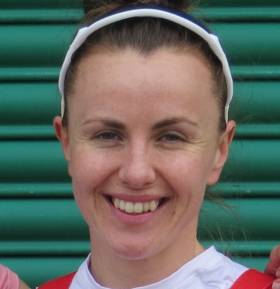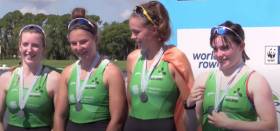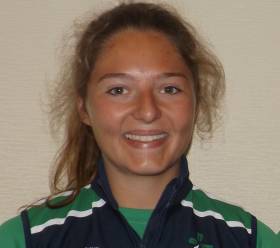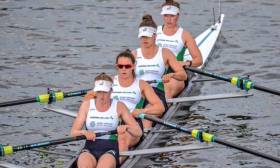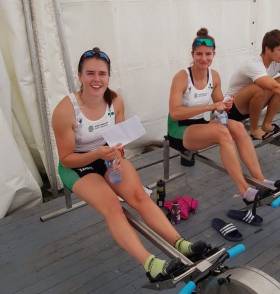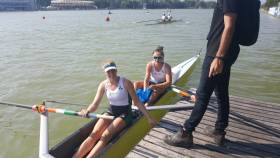Displaying items by tag: Emily Hegarty
Olympic Place Evades Ireland Women's Four at World Championships
#Rowing: Ireland's ambitions of booking a slot for a fifth boat at Tokyo 2020 came up short. The Ireland four of Tara Hanlon, Eimear Lambe, Aifric Keogh and Emily Hegarty had the difficult task of taking a top-two place in their B Final. They found their pace coming up to the line, but Britain, in lane five, and Canada in lane six took the crucial spots, with Ireland finishing fourth behind third-placed China.
The crosswind was a problem during the race and immediately afterwards the authorities redrew the lanes to acknowledge that lanes five and six were favoured.
World Rowing Championshiops, Linz-Ottensheim, Day Seven (Irish interest)
Women
Four - B Final (First Two book Olympic places for boat): 1 Britain 6:55.08, 2 Canada 6:56.99; 3 China 7:02.28, 4 Ireland Ireland (T Hanlon, E Lambe, A Keogh, E Hegarty) 7:02.71.
Pair - B Final (First Five book Olympic places for boat): 1 Romania 7:18.88, 2 Ireland (A Crowley, M Dukarska) 7:20.68.
Lightweight Double Sculls - C Final (Places 13 to 18) 1 China 7:00.82; 5 Ireland (A Casey, D Walsh) 7:10.52.
Third Place in Heat for New Ireland Four at World Championships
#Rowing: The Ireland women’s four gave a good account of themselves on their first competitive outing together, just missing out on direct qualification from their heat of the World Rowing Championships in Linz, Austria.
Tara Hanlon, Eimear Lambe, Aifric Keogh and Emily Hegarty came up against Australia, who were dominant, and the United States, who overcame a poor start to take the second available semi-final spot. The Ireland crew pushed them right to line, with just 1.89 seconds between them at the finish.
World Rowing Championships, Linz, Austria, Day One (Irish interest)
Men
Pair – Heat One (First Four to Quarter-Finals; rest to Repechage): 6 Ireland (M O’Donovan, S O’Driscoll) 6:50.51.
Lightweight Double Sculls – Heat Three (First Three to Quarter-Finals; rest to Repechage): 1 Ireland (F McCarthy, P O’Donovan) 6:28.02
Women
Four – Heat One (First Two to A/B Semi-Finals; rest to Repechage): 3 Ireland (T Hanlon, E Lambe, A Keogh, E Hegarty) 6:44.72.
Pair – Heat Four (First Four to Quarter-Finals; rest to Repechage): 2 Ireland (A Crowley, M Dukarska) 7:13.30
Lightweight Double Sculls – Heat Four (First Four to Quarter-Finals; rest to Repechage): 4 Ireland (A Casey, D Walsh) 7:25.62.
#Rowing: The Ireland women’s four which took silver at the World Under-23 Championships in Florida are the Afloat Rowers of the Month for July.
It was a month of outstanding achievements for Ireland rowers. The men’s double of Philip Doyle and Ronan Byrne and the lightweight double of Paul O’Donovan and Fintan McCarthy both took silver medals at the World Cup regatta in Rotterdam – Paul O’Donovan fishing a stroke coach from the water and immediately getting back to racing. Gary O’Donovan took bronze in the lightweight single sculls.
The Irish Championships was the biggest ever, featuring the emergence of new young crews such as junior single sculls champion Holly Davis, and capped off with wins in the women’s senior eight for NUIG/Castleconnell and the men’s senior eight for UCD. Davis (14) went on to win gold in the junior single sculls the Home International Regatta, and the men’s junior eight, pair and quadruple also won gold.
Three Irish crews – UCD, Commercial and Skibbereen’s Mark O’Donovan and Shane O’Dricoll – reached semi-finals at Henley Royal Regatta.
The World Under-23 Championships in Sarasota Bradenton saw the men’s coxed four take seventh, the lightweight women’s double fourth, and the lightweight men’s quadruple take a bronze medal.
The achievement of the women’s under-23 four of Claire Feerick (Neptune), Eimear Lambe (UCD), Tara Hanlon (UCC) and Emily Hegarty (UCC) was historic. They became the first Ireland women’s crew in a sweep event to take a medal at a World Championships.
They are the Afloat Rowers of the Month.
Rower of the Month awards: The judging panel is made up of Liam Gorman, rowing correspondent of The Irish Times and David O'Brien, Editor of Afloat magazine. Monthly awards for achievements during the year will appear on afloat.ie. Keep a monthly eye on progress and watch our 2019 champions list grow.
#Rowing: Ireland took a silver medal at the World Rowing Under-23 Championships today through the women’s four of Claire Feerick, Eimear Lambe, Tara Hanlon and Emily Hegarty, who swapped into the stroke seat for Lambe.
Britain and Ireland swept into the lead early and were clear of the rest in the final quarter. Britain found just enough to beat Ireland by 1.46 seconds.
World Rowing Under-23 Championships, Sarasota Bradenton, Florida (Irish interest)
Women
Four – A Final: 1 Britain 6:34.22, 2 Ireland (C Feerick, E Lambe, T Hanlon, E Hegarty) 6:35.68, 3 United States 6:39.89.
Third Spot in Fast Heat for Ireland Four in Florida
#Rowing: Ireland took third place in a fast heat of the women’s four at the World Rowing Under-23 Championships in Sarasota-Bradenton in Florida.
The winner alone went directly through to the A Final. The United States claimed this spot, with Britain and Ireland closing fast coming to the line. This was much the faster of the two heats.
The Ireland crew of Claire Feerick, Emily Hegarty, Tara Hanlon and Eimear Lambe would hope to qualify through their repechage on Thursday.
World Rowing Under-23 Championships, Sarasota-Bradenton, United States (Irish interest)
Men
Four, coxed – Heat Two (Winner to A Final; rest to Repechages): 1 Australia 6:11.99; 4 Ireland (B O’Rourke, R Corrigan, D Lynch, J Quinlan; cox: E Finnegan) 6:18.79.
Women
Four – Heat One (Winner to A Final; rest to Repechages): 1 United States 6:32.15; 2 Britain 6:32.96, 3 Ireland (C Feerick, E Hegarty, T Hanlon, E Lambe) 6:33.10.
Ireland Four To Compete in B Final at World Cup Rowing
#Rowing: The Ireland women’s four are set for a B Final on Sunday after finishing sixth in their semi-final at the World Cup Regatta in Poznan. Australia beat the United States One crew after an exciting contest in this semi-final, with China producing good finish speed to take third – and a place in the A Final – from New Zealand.
Ireland’s crew of Tara Hanlon, Monika Dukarska, Aileen Crowley and Emily Hegarty were fifth at halfway, over a length off the top-four, and finished behind Britain Two, who took fifth.
World Cup Regatta, Poznan, Poland – Day Two (Irish interest)
Women
Four – Semi-Final One (First Three to A Final; rest to B Final): 1 Australia 6:54.54, 2 United States One 6:55.52, 3 China 6:55.87; 6 Ireland (T Hanlon, M Dukarska, A Crowley, E Hegarty) 7:08.16.
Pair – Semi-Final One (First Three to A Final; rest to B Final): 1 New Zealand 7:32.18, 2 Italy One 7:35.99, 3 China One 7:36.43; 6 Ireland (C Feerick, E Lambe) 7:51.17.
Ireland Women's Four Finish Well and Nail Semi-Final Place
#Rowing: Ireland’s women’s four joined the women’s pair in the semi-finals of the World Cup regatta in Poland. The top three crews from the fours repechage qualified, but Ireland sat fifth at halfway. Canada moved away and opened a small lead; Ireland sat fourth with 500 metres to go. Croatia, Ireland and Britain Two finished best to take the top three places.
World Cup Regatta, Poznan, Poland, Day One (Irish interest)
Women
Four
Heat One (First Three to A/B Semi-Finals; rest to Repechage): 1 Australia 6:32.50, 2 United States Two 6:33.57, 3 Britain 6:35.69; 4 Ireland (T Hanlon, M Dukarska, A Crowley, E Hegarty) 6:38.44. Repechage (First Three to A/B Semi-Final; rest to C Final):
1 Croatia 6:47.12, 2 Ireland 6:47.49, 3 Britain Two 6:48.19.
Pair
Heat Two (Winner to A/B Semi-Final; rest to Repechages): 1 Italy Two 7:07.10; 2 China Two 7:09.55, 3 Ireland (E Lambe, C Feerick) 7:10.31. Repechage One (First Two to A/B Semi-Final; next two to C Final; rest to D Final): 1 United States One 7:15.35, 2 Ireland 7:19.33; 3 Canada One 7:26.52.
Ireland Four Bound for World Cup Repechage in Poznan
#Rowing: The Ireland women’s four took fourth in their heat, missing out on direct qualification for the semi-final, at the World Cup Regatta in Poland this morning. The crew of Tara Hanlon, Monika Dukarska, Aileen Crowley and Emily Hegarty will compete in a repechage later today.
Australia and the United States Two fought it out for the win, with Australia taking top spot. Ireland and Britain battled for the third and final qualification spot, which Britain took.
World Cup Regatta, Poznan, Poland, Day One (Irish interest)
Women
Four
Heat One (First Three to A/B Semi-Finals; rest to Repechages): 1 Australia 6:32.50, 2 United States Two 6:33.57, 3 Britain 6:35.69; 4 Ireland (T Hanlon, M Dukarska, A Crowley, E Hegarty) 6:38.44.
Pair
Heat Two (Winner to A/B Semi-Final; rest to Repechages): 1 Italy Two 7:07.10; 2 China Two 7:09.55, 3 Ireland (E Lambe, C Feerick) 7:10.31.
O'Donovan Brothers & Puspure Chosen as Afloat Rowers of Month
#Rowing: Ireland’s gold medallists at the World Championships, Paul and Gary O’Donovan and Sanita Puspure, are the Afloat Rowers of the Month for September.
The whole Ireland team performed with merit at the regatta in Plovdiv in Bulgaria and there were a number of outstanding placings. The men’s lightweight quadruple reached their A Final, while Philip Doyle and Ronan Byrne finished ninth overall in the men’s double sculls.
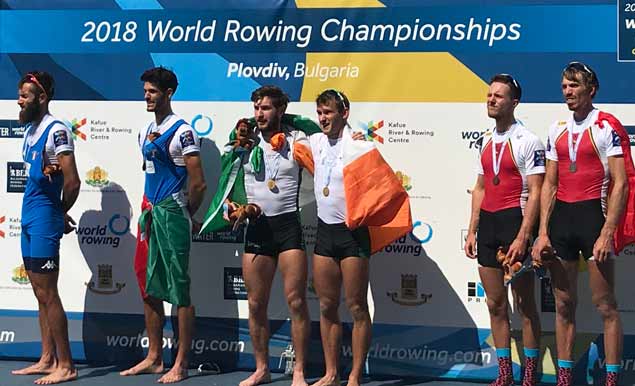 Gary and Paul on the podium in Plovdiv with Italy and Belgium Photo: Liam Gorman
Gary and Paul on the podium in Plovdiv with Italy and Belgium Photo: Liam Gorman
The women’s pair of Aifric Keogh and Emily Hegarty swept into the A Final, one of the real shocks of the Championships. They took sixth.
The O’Donovan brothers had to battle through a terrible lane draw on the Wednesday to reach Thursday’s semi-final. It left them tired and they made it through to the final by taking the third qualification place in the semi-final with just 1.52 seconds to spare over Poland. Come the final it was a step up; a step into history. They made light of their outside lane with a sweet and powerful row they deemed their best ever as a lightweight double. Italy could not live with it and Ireland had won their first ever gold medal in an Olympic event at a World Championships.
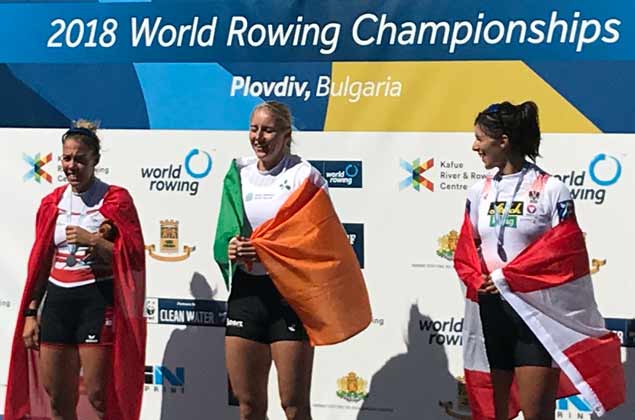 Sanita Puspure on the podium in Plovdiv Photo: Liam Gorman
Sanita Puspure on the podium in Plovdiv Photo: Liam Gorman
The women’s single sculls has been a fascinating event for years. Australia’s Kim Crow (now Brennan) was the star who shone all the way to a golden show in Rio in 2016; latterly Switzerland’s Jeannine Gmelin has been a winner. And now the time had come for Ireland’s Sanita Puspure. She won the heat and the semi-finals with elan, as if impatient to take on and beat Gmelin. She did this despite having to deal with choppy conditions in the final and she clipped a buoy. However, Puspure was never headed from early on, and she won with over two lengths to spare. For seven minutes and 20.12 seconds she was, indeed, dominant.
Congratulations to all the Ireland teams this season and to the Afloat Rowers of the Month, Sanita Puspure and Paul O’Donovan and Gary O’Donovan.
Rower of the Month awards: The judging panel is made up of Liam Gorman, rowing correspondent of The Irish Times and David O'Brien, Editor of Afloat magazine. Monthly awards for achievements during the year will appear on afloat.ie. Keep a monthly eye on progress and watch our 2018 champions list grow.
Sixth Place for Hegarty and Keogh in World Rowing Final
#Rowing: Ireland finished sixth in the A Final of the women’s pair at the World Rowing Championships in Plovdiv, Bulgaria. New Zealand and Canada covered the first 500 metres best, but Aifric Keogh and Emily Hegarty passed through that mark at the back of the field. The pattern of the race developed in the same way: Canada came through New Zealand by the finish, and the two took gold and silver. Spain won a battle with Italy to take bronze. Keogh and Hegarty skirmished with China coming into the closing stages but eventually took the final spot.
World Rowing Championships, Plovdiv, Bulgaria, Day Seven (Irish interest):
Women
Pair – A Final: 1 Canada 6:50.67, 2 New Zealand 6:52.96, 3 Spain 7:04.60; 6 Ireland (A Keogh, E Hegarty) 7:15.70.


























